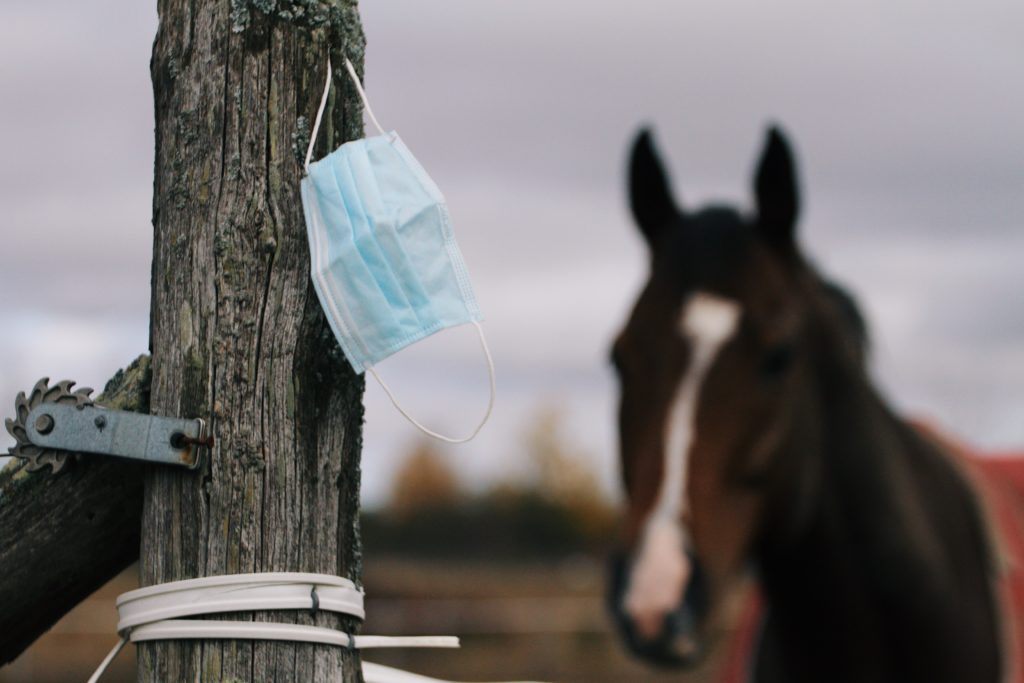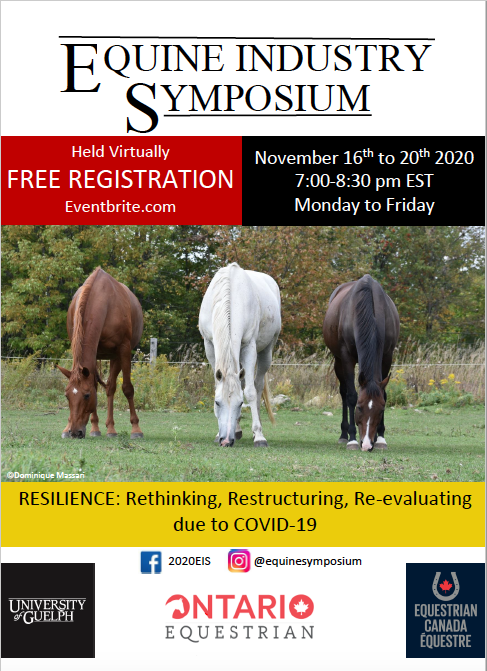The silver lining of COVID-19 for horse communities
Looking Back on the 2020 Equine Industry Symposium & Webinar Replays
By Kaitlyn Graff, Equine Management student
Over the course of the last nine months, COVID-19 has proved to be challenging for everyone. People in the equine industry have faced significant hardship, isolation and financial impacts. These unforeseen circumstances provided an opportunity for horse enthusiasts to come together and discuss how to best support each other during these unprecedented times.
The 5th annual Equine Industry Symposium, organized by students in the Bachelor of Bio-Resource Management Equine Management major at the University of Guelph, and hosted in partnership Ontario Equestrian and Equestrian Canada, focused on specific topics within the Symposium’s theme of “Resilience: Rethinking, Restructuring, Re-evaluating due to COVID-19” from November 16-20, 2020. As with many gatherings this year, the Equine Industry Symposium was held for the first time virtually, allowing almost 300 participants to attend from eight different countries.

Whether facilities were financially impacted, owners were unable to take care of their horses, or students were unable to attend their lessons, the pandemic caught many people in the equine industry off guard. The Equine Industry Symposium addressed these circumstances by facilitating dialogue about how we as a community can overcome these challenges.
The first evening presentations highlighted the overarching impacts of the pandemic on the equine community. Bronwynne Wilton from Wilton Group Consulting presented the main findings from an examination of the equine industry in Canada undertaken in March of this year. Essentially, the number of equids in Canada is unknown due to their many and varied uses which does not accurately classify them. The recommendation was to accept the term “active equine” to describe an animal who directly contributes to revenue generation in an “active equine facility”.
It was clear that the majority of equine businesses had one month or less of reserves to care for their animals in the face of revenue cessation due to COVID-19 restrictions, and the cost of assistance to cover the basic care of these horses would be $12.9 million per month. Danielle Glanc from the Ontario Federation of Agriculture supported these statements, indicating that equine facility owners need to work to place active equines visibly in the agricultural sector. Christine Reupke, organizing director of the Royal Agricultural Winter Fair Horse Show, explained the impact of COVID-19 on the decision to cancel the show and steps taken to keep the Royal spirit alive through virtual events. Jonathan Zammit, CEO of Ontario Racing, focused on the impact of COVID-19 on all three racing sectors, and how the racing industry provided financial support by redirecting almost $12 million of purse money to directly offset the costs of care for horses that were no longer able to race due to closures of race tracks.
The second evening session discussed methods of restructuring the business for success. Dr. Melanie Barham, a veterinarian and an MBA candidate with a major in Sustainable Commerce, discussed the importance of business planning, different models of business plans, as well as how these can help determine value propositions. Sean Jones, an advisor with Sun Life Financial and an avid equestrian, enlightened the audience by presenting five important considerations for business owners: revenue streams, revenue generation per horse, elimination of unnecessary expenses, virtual teaching/ monetization and emergency funding. Mike King, Partner and National Equine Industry lead at the general insurance brokerage CapriCMW Insurance Services, and Catherine Willson, a specialist in equine law, answered questions most people would have regarding risk assessment and the legal obligations that facilities face during COVID-19, as well as how businesses can protect themselves and others during this time.
The third evening featured Gayle Ecker, director of Equine Guelph, who introduced the Code of Practice for the Care and Handling of Equines. This was aptly followed by Dr. Roly Owers, CEO of World Horse Welfare, who expanded on what is meant by welfare and how to monitor and meet equine welfare needs during the changing landscape of the pandemic. Finally, veterinarian Dr. Bettina Bobsien tackled the difficult topic of end of life planning with consideration to ethics, quality of life, finances and contractual obligations.
The fourth evening was all about the importance of emergency preparedness and equine traceability. Stewart Everett, CEO of Equine Register in the UK, presented the innovative technology that not only identifies an animal, but can track movement, enter equestrian competitions, and provide secure access to health records. Dr. Nic de Brauwere, Head of Welfare and Behaviour at the Redwings Horse Sanctuary, UK, discussed the benefits of this centralized equine database including reaching owners to share relevant, trusted information and advice essential for protecting and promoting the welfare and health of their horses. Kristy House, Manager of Welfare and Industry with Equestrian Canada, followed up with plans for implementing a traceability program in Canada. Subsequent to the symposium, Equestrian Canada announced its partnership with Equine Register to launch the Canadian Equine Identification Program (CEIP).
Kristy House from Equestrian Canada was back on the last evening to highlight the pandemic positives from a national level perspective as a governing body of the industry. Both federal and provincial government recognition of the equine industry has moved forward which bodes well for the acceptance of the “active equine” definition provided on the first evening. Tracey McCague-McElrea, executive director of Ontario Equestrian, echoed their steps in supporting the equine industry, including the For the Herd initiative to assist riding lesson facilities during these times of financial crises. The Equine Information Source, a group of undergraduate students, demonstrated the resources they created over the summer to assist horse owners and facility managers such as infographics and short video interviews with industry professionals. Finally, Assistant Deputy Minister Agriculture and Agri-Food Canada, Frédéric Seppey discussed how the government can support the equine community and how the industry is positioned to adapt to the support given.

The Equine Industry Symposium provides an important outlet for networking and maintaining industry connections. As participants of the equine industry, we may at times feel disconnected or isolated from one another, and COVID-19 has created further isolation. By exploring and discussing these challenges, we are able to become more resilient and prepared for future industry hardships. For those who were unable to attend the live sessions, all sessions were recorded and are now posted on the Horse Portal, or watch the playlist on the BBRM youtube channel. In future, we will continue to include an online aspect to our Symposium so that people may attend world-wide. Thank you to all presenters and attendees for making this year’s Symposium such a success.

